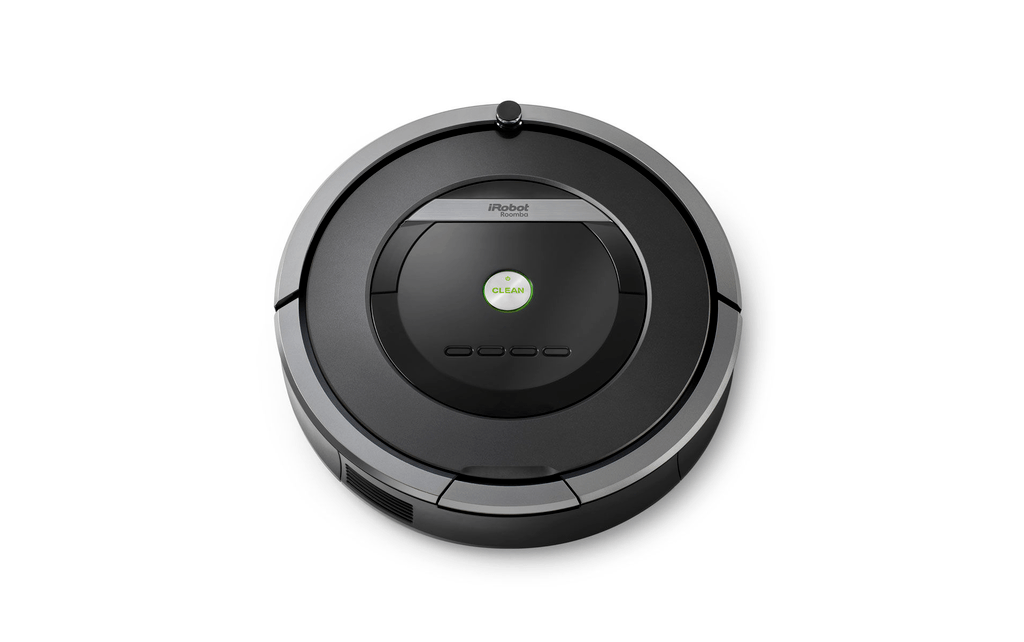If you are searching for the best Roomba vacuum for your home, there are just as many choices as there are floor plans in your city. There are also a lot of things to consider such as price, features, abilities and style. Should the Roomba 877 make your list?
This review will cover the Roomba 877 and give you all the details about its features, abilities and where it falls short. I will also show you a few alternatives in case you decide it is not the right model for you. Read on below and find out if the Roomba 877 is a good match for your home.
Contents
Who is the Roomba 877 For?
The Roomba 877 is a good fit for a lot of people looking to get into the home robotics market. If it interests you, you may find that the 877 is a match if you:
- Want the advanced cleaning features of the later 800 series line up.
- Don’t need all the bells and whistles of the 900 series.
- Aren’t looking to control your vacuum with the mobile app or voice commands.
- Need HEPA filtration to help reduce allergens.
- Have high pile carpeting and need something that won’t get stuck on it.
Who the Roomba 877 is Not For
Unfortunately, not every robotic vacuum can be for every person or every home. You may find that the 877 isn’t a good fit if you:
- Require remotes or apps for control of the robot.
- Need advanced reports and location tracking.
- Want to have the latest version of navigation and mapping capabilities.
Dimensions, Features and Options
I will now take a look at the most prominent features of the Roomba 877 and explain in more detail what they mean to you.
The Battery is an Upgrade You Should Take Note of.
The 800 series came out using the Nickel-Metal Hydride battery packs and quickly evolved into the lithium-ion battery packs. By the time the Roomba 890 came out, the lithium-ion packs were larger and given the name XLife.
When iRobot released the 877, it contained many features of the later stages of the 800 series and removed some of the earlier stages. The Roomba 877 is a hybrid machine designed to save you money by only having what you need and nothing you don’t.
The battery is one such improvement over the 880 that the 877 has. The XLife battery pack is a 3300mAh battery that will charge quickly and drain slowly. It has double the runtime of the 870 and 880 by being able to run up to 120 minutes on a single charge.
The charging time is also lowered. At most, it will take four hours to recharge the unit completely. However, you will find that the true full charge is closer to three hours. The good news is that you don’t really need to monitor the battery life.
When the battery level drops to anything below 15 percent, the robot will automatically return to the charging station and recharge on its own. One of the nice features of the 900 series is called “entire level cleaning” and what this means is that after a recharge, the robot will continue from where it left off.
The Roomba 877 does not have this feature. It will automatically recharge but it will not resume cleaning from where it left off until you manually tell it to do so. If you have a large floor plan or a lot of carpet, you may notice you have to restart the robot often. Usually, this will not be the case.
With the XLife battery and the impressive runtime, you can easily cover up to 1500 square feet in a single charge. Of course, the dirtier your flooring is, and the more carpet you have this number will dwindle more and more.
Finally HEPA filtration in a Roomba, Well, Kind of…
HEPA certified filters are an important aspect of consumers, especially those that suffer from allergies. With HEPA filtration you are getting 99 percent of all allergens in your home collected by the filter.
HEPA certification promises that particles down to three microns in size will be captured. This will capture mites, pollen, pet dander and other airborne and settled particles. With the 700 series and earlier, and even some early 800 series Roomba vacuums, you didn’t get HEPA certified filtration.
The AeroVac technology had AeroVac filters that captured particles to 10 microns in size. However, with the advent of the new generation, AeroForce technology gave Roomba the capability to use HEPA filtration.
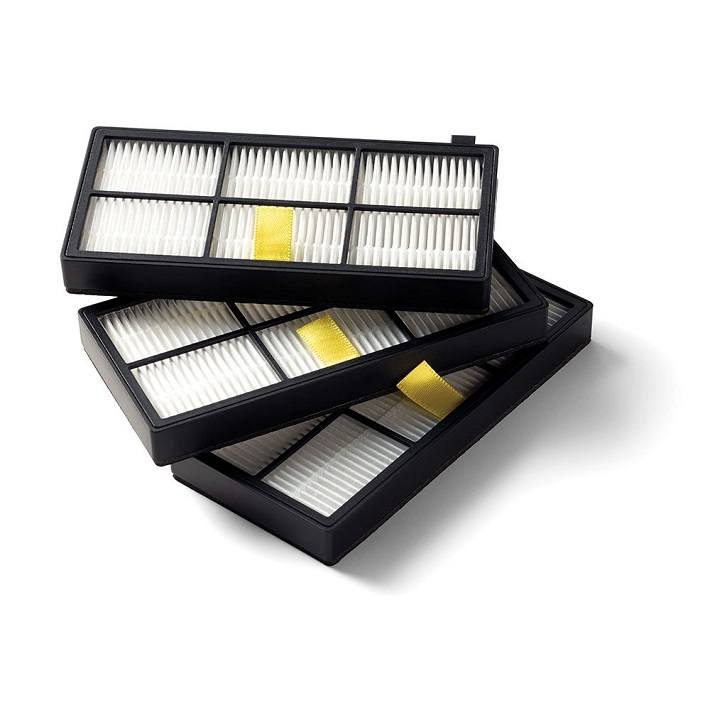
HEPA filters are in the Roomba 877, but you won’t be able to tell by looking at the packaging or the owner’s manual. Everything will be referred to as “AeroForce High-efficiency” filters. I do not know why iRobot removed the HEPA designation, which they have for almost every one of their Roomba models.
However, the filters are still able to collect particles and allergens down to three microns. Without the actual certification, they cannot put the label on their packaging. It is there, though, I can promise you that. Any time you see the “high-efficiency” on the filter, it is a HEPA filter.
I am sure iRobot has a reason for doing this, I just haven’t been able to, yet, uncover what that reason is. However, if you do suffer from allergies you know to be on the lookout for the HEPA seal. Just know that when looking at Roomba models, to also look for high-efficiency tags.
The Extractors Don’t Have Bristles, and They Detangle Themselves
Introduced late in the 800 series was the tangle-free brushless extractors. Instead of having a brush bar like a standard upright vacuum, the 880 and 890 introduced dual, counter-rotating rubber extractors. They have raised edges and grooves that interlock as the bars rotate.
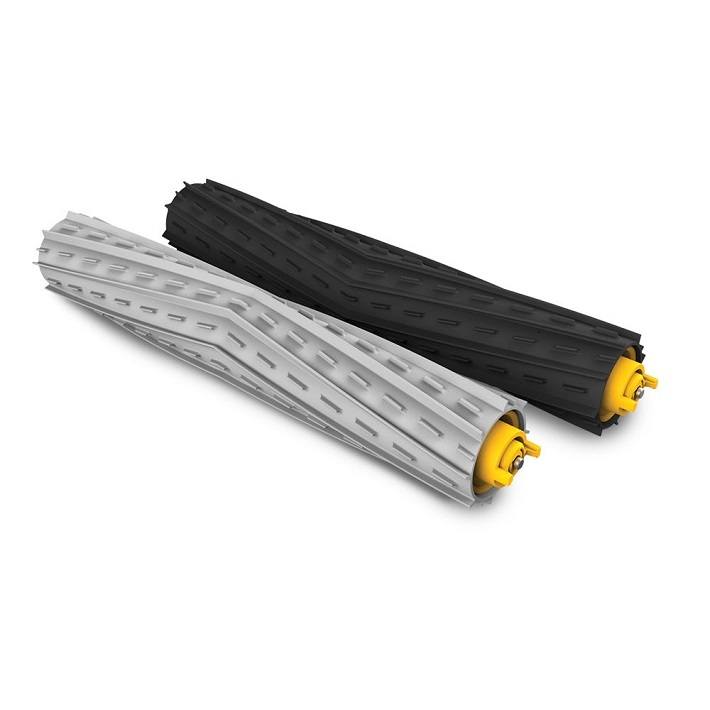
Using this instead of bristles, the dirt, dust and debris are able to be collected, pushed into the air chamber and tangles from string and hairs is less likely.
Eventually, as with everything that rotates, something will get tangled around. Pet hairs and string, carpet fibers, etc. However, because there aren’t any bristles, cleaning them off is as simple as wiping them down.
The Roomba 877 takes advantage of the brushless extractors which also have the ability to detect possible tangles from cords, large debris (such as socks, toys, etc.)
What happens is the sensors will tell the robot that a possible tangle is happening and the robot will stop and reverse the motor. This will turn the extractors the opposite way and push the debris, cord or whatever the obstruction is back out. The robot, if able to free itself, will then attempt to go around the object to continue cleaning.
If the Roomba 877 is not able to free itself, it will send out the beep alarm to alert you it is stuck and it will shut down. By shutting down, it will preserve battery life and prevent damage to either the object or itself, until you can manually free it
You won’t find the brushless extractors in the early 800 series models, but like them, the extractors self-adjust to the floor height to get you the best possible clean, regardless of what flooring material is underneath.
With the iAdapt navigation technology, the Roomba 877 will be able to maneuver around your home with relative ease. As with any robot vacuum on the market, there will be occasional collisions and accidents.
However, the iAdapt technology, along with the sensors on the robots working together, will prevent hard collisions, falls, tumbles or damage. The more the robotic vacuum navigates and maps your home, the less often this will happen.
The drop sensors tell the navigation system that stairs or a ledge greater than an inch and a half is present. The robot will change direction and avoid the fall.
The bump sensors use infrared and acoustic sensing to know when an object such as furniture and walls are present and in what direction. As the robot approaches, it will slow down to avoid a heavy collision. In the event of contact, the touch sensors will alert the robot of the collision and it will immediately change direction to avoid damage.
Late in the 900 series, iRobot introduce the iAdapt 2 technology that also incorporates more sensors and visual navigation and mapping through the use of a camera. While this technology isn’t in the 877, the use of iAdapt is still one of the best in the industry.
Containment Takes a Slight Backwards Step
Roomba is known for their containment units. The virtual wall barriers are arguably the best method of robotic containment currently on the market. The barriers are dual mode and can produce a single infrared beam across a threshold or entry way to prevent exit or entrance. They can also produce a ring around the device that will protect anything inside it.
The later 800 series models use these barriers. The Roomba 877, however, makes use of the first form of these barriers known as virtual lighthouses.
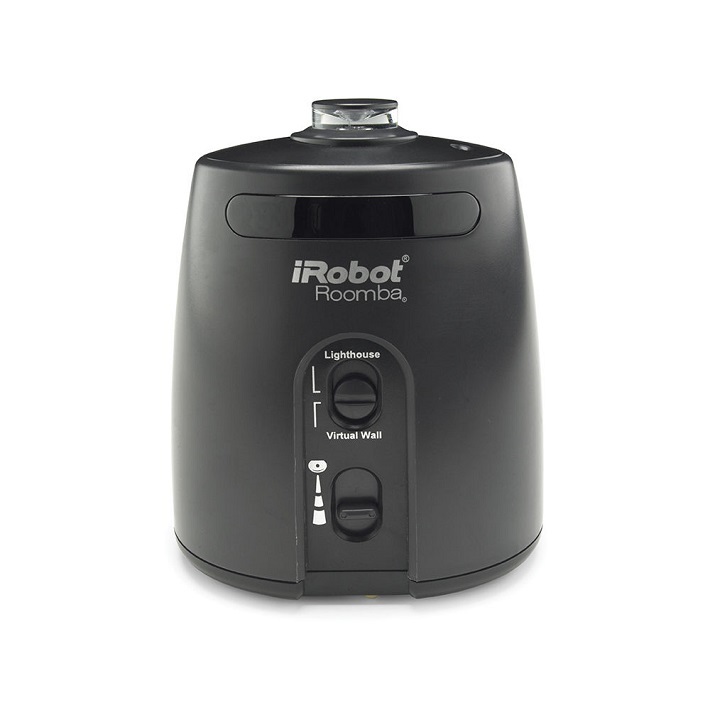
They work in a similar way in that they can produce a single infrared beam to place across doorways to prevent access or exit. The second mode, however, works a little different. In lighthouse mode, the device actually guides the robot from one room to an adjoining room.
With this active, the two rooms technically become one single room with a guided entry and exit point. The lighthouse will constantly update the machine with its location so it knows how to get back out and that point will be the only area it enters or leaves the room at.
When all is said and done the lighthouse is still a nice feature and works well. However, the wall barriers do a much better job at containment and protection.
You will receive one virtual lighthouse with the Roomba 877, but you can purchase more directly from iRobot or third party vendors online.
Features and Options Chart
Let’s take a look at the Roomba 877 in an easy to read chart so you can see what it has (or doesn’t have) at a glance.
| Roomba 877 | |
| Dimensions | 13.9×13.9×3.6 inches |
| Weight | 8.7 pounds |
| Battery | XLife lithium-ion 3300mAh |
| Runtime | Up to 120 minutes |
| Recharge time | 3 hours |
| Automatic Recharge | Yes |
| Wireless Communications | No |
| Mobile App | No |
| Voice Controls | No |
| Remote Control | No |
| Local Controls | Yes |
| Scheduling | Yes |
| Edge Cleaning | Yes |
| Spot Cleaning | Yes |
| Containment | Virtual Lighthouse |
| Filtration | AeroForce High-efficiency |
| Navigation | iAdapt Technology |
| Extraction Method | AeroForce technology with brushless extractors |
| Warranty | 1 year |
Alternative Options
If you have read this far and think the Roomba 877 may not be the best fit for you or your family, here are a few options that you may want to consider.
Roomba 890
As far as the price point goes, Roomba 890 is more expensive. What you get with the extra cost, though, is a machine that cleans in the exact same manner and just as well. With the same navigation and mapping, you will get the expected Roomba cleaning.
[easyazon_image align=”center” height=”500″ identifier=”B06XS31V18″ locale=”US” src=”https://smartrobotichome.com/wp-content/uploads/2018/08/419jhshvL.jpg” tag=”srh-easyazon-20″ width=”500″]You will also get wireless communications. This will enable you to use the mobile app for control and programming. The app is quite possibly the best in the industry. You will also have the ability to integrate with Amazon Alexa devices as well as Google Home for voice control.
EcoVac DeeBot M80
This little vacuum tries to do it all by allowing you also to mop hard flooring. The carpet clean isn’t as complete as the Roomba 877, but with the added mop functionality you will also be able to spot clean your kitchen floors.
Further, you will have wireless communications for use with the (sometimes cumbersome) mobile app and voice commands. The main problem with the DeeBot M80 is the inability to clean medium or high pile carpets very well. If you have mainly hard flooring, though, it could be something to think about.
Dyson 360 Eye
This name is synonymous with floor cleaning. Dyson however, tried to do too much with their entry into the robotics market. The 360 Eye attempted to take on the Roomba 980 head on and came up well short.
However, versus the Roomba 877 is it quite competitive. You will have a better cleaning pattern and visual mapping with the camera. You will, though, pay a premium price for a machine that has promise but may not be that noticeable in overall cleaning ability compared to the 877.
Frequently Asked Questions
I will take the time to answer a few of the more commonly asked questions asked about the Roomba 877 so you can have all the information you need.
Q. How often will I need to empty the dustbin?
A. You will need to keep up with the maintenance and part of that is keeping the collection bin empty. How often will depend on how much debris it collects from your floors. If you have shedding pets and a lot of heavy foot traffic you will empty it a lot more often than those homes without pets.
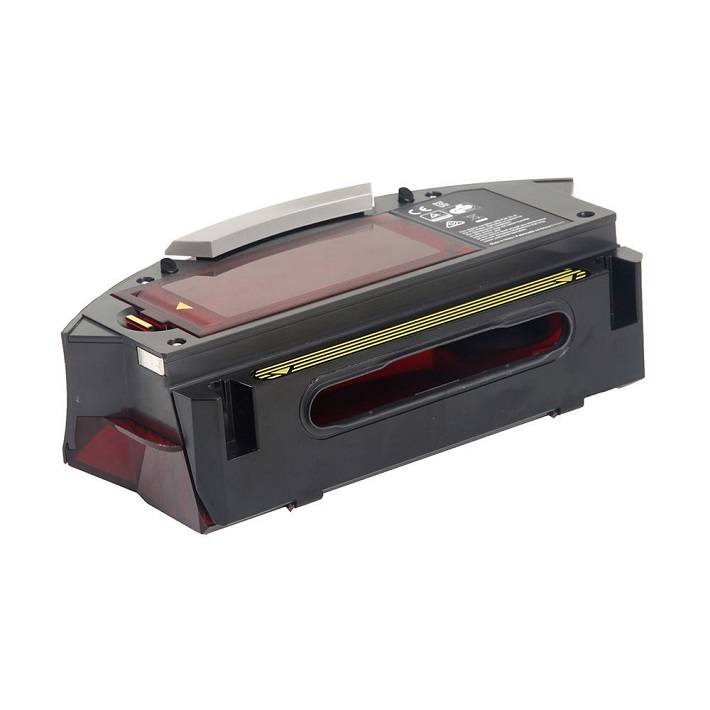
The good news is that you don’t have to guess. You will be able to see the LED on the robot alerting you that the bin is full and in need of a change. You will also get a feel for how often this happens and when you should know to look for the illuminated indicator.
Q. I have a black carpet and the last robotic vacuum I had wouldn’t go on it, will the Roomba 877 have more luck?
A. It is possible but unlikely. The infrared sensors that detect ledges and drops are actually absorbed by the dark colors of your flooring. Because of this, it is interpreted as a drop-off and the robots will avoid the area.
You can, according to consumer reports, place a piece of tape over the drop sensor and in essence disabling this function. However, if you do have drop-offs or stairs, I wouldn’t suggest you do this unless you are physically present to keep the vacuum from taking a fall.
Q. If it does make contact with furniture or walls will it cause damage?
A. I can’t make a promise, nor would I do so. However, I can safely say that it isn’t likely. The rubber bumper around the device prevents a lot of damage from collisions. Also, the iAdapt navigation technology and sensors work very well at alerting the unit it is headed for a solid object.
When this happens the robot will slow down, avoid the collision, or if collision happens, it won’t be detrimental at all.
In Conclusion
While not every robot vacuum will be the best option for every home, the Roomba 877 has some exciting advancements and price point to allow a decent fit for a lot of homes. You will have world-class navigation and mapping technology and a vacuum that works well on all floor types.
If, however, you are looking for more controls, either via remote, mobile app or voice, you will need to look elsewhere. If you want a simple to operate machine and clean floors though, the Roomba 877 might be a good fit for your home, even those that have allergy sufferers.
In a Nutshell
The Roomba 877 is a hybrid between the basic features of the early 800 series models and the advances of the late 800 series and early 900 series models. It is the best of both worlds stripped down to lower the cost. It may not be enough for everyone, but for those that fit, it is a great machine.
What I Like
- Brushless Extractors keep tangles to a minimum.
- Navigation is almost flawless.
- High-efficiency filtration keeps allergens to a minimum.
What I Don’t Like
- No wireless communications which prevent easier controls.
- You don’t have the added top end features like carpet boost.
- No entire level cleaning for larger floor plans.
